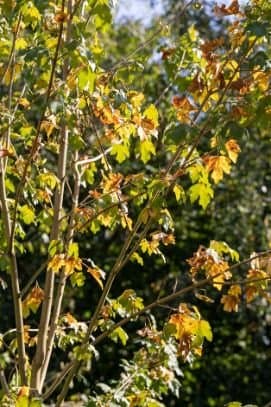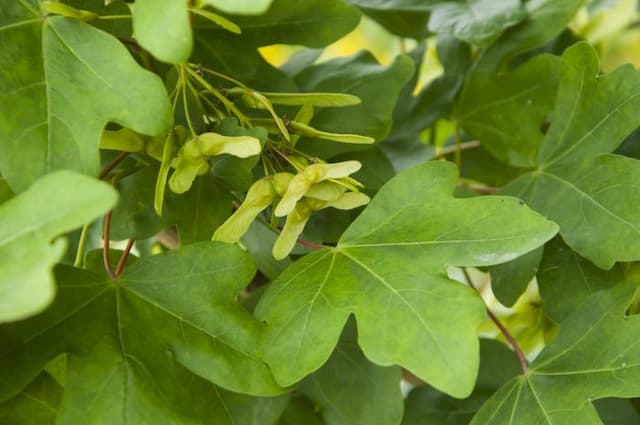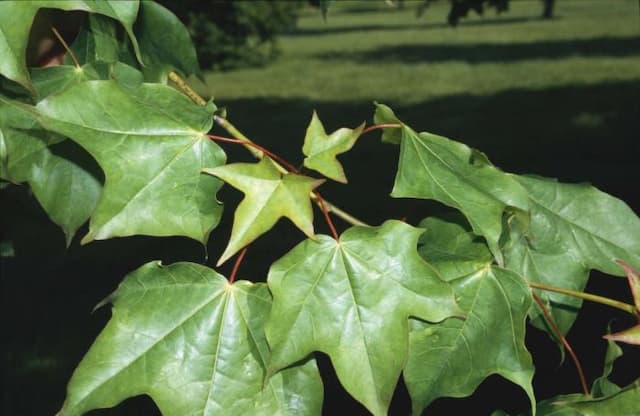Japanese Maple Acer palmatum 'Koto-no-ito' (L)

ABOUT
Koto-no-ito, often referred to as the "Harp String Maple", is a deciduous tree that is renowned for its ornamental qualities. Its name translates to "strings of the koto" (a traditional Japanese stringed instrument), which perfectly describes the plant's delicate, string-like foliage. The leaves of this variety are unique in comparison to other maples; they are palmate, meaning they have several deep lobes radiating from a central point like the palm of a hand, with elongated, narrow lobes that give an appearance similar to that of long, thin fingers. The leaves are initially green in spring, providing a soft, lacey texture that is refreshing to the eye. As the seasons change, Koto-no-ito undergoes a striking transformation; during the autumn months, the foliage turns into a vibrant display of gold, orange, and red hues, offering a dramatic contrast to the landscape. The arrangement of the leaves is such that they flutter and dance in the wind, much like the strings of a musical instrument, creating a serene and picturesque movement. The bark of the Koto-no-ito is a smooth grey, offering a subtle backdrop which further accentuates the brilliant color of the foliage. Compared to other maples, this tree has a gentle, cascading branch structure which contributes to its elegant and refined appearance. In the landscape, Koto-no-ito is often used as a focal point because of its unique leaf shape and stunning fall coloration. The overall visual effect of this plant is one of grace and lightness, making it a prized specimen in any garden setting.
About this plant
 Names
NamesFamily
Sapindaceae
Synonyms
Harp String Maple, Koto No Ito Japanese Maple
Common names
Acer palmatum 'Koto-no-ito'
 Toxicity
ToxicityTo humans
The Japanese Maple is generally not considered toxic to humans. There are no widely recognized symptoms of poisoning from ingesting parts of this plant, as it is not known to contain substances that are harmful to people when touched or consumed in typical amounts found in the plant.
To pets
The Japanese Maple is also generally considered non-toxic to pets such as dogs and cats. It does not usually cause poisoning or any adverse health effects when pets chew on or ingest its leaves or other parts. Therefore, there are no specific symptoms associated with poisoning from the Japanese Maple in pets.
 Characteristics
CharacteristicsLife cycle
Perennials
Foliage type
Deciduous
Color of leaves
Green
Height
10 feet (3 meters)
Spread
5 feet (1.5 meters)
Plant type
Tree
Hardiness zones
5
Native area
Japan
Benefits
 General Benefits
General Benefits```html
- Ornamental appeal: 'Koto-no-ito' is prized for its fine-textured leaves and elegant form, making it a visually attractive addition to any landscape or garden.
- Seasonal interest: This variety of Japanese maple provides year-round interest with its changing foliage colors, from green in spring to golden in fall, and sometimes even crimson.
- Shade provider: As a small to medium-sized deciduous tree, it can offer light shade, making it suitable for planting in garden areas that require protection from intense sunlight.
- Compact size: It is well-suited for small gardens or spaces, as it does not grow too large, so it can be easily maintained and incorporated into different landscape designs.
- Low maintenance: Once established, this plant requires minimal care beyond occasional pruning and regular watering, making it a convenient choice for both beginner and experienced gardeners.
- Habitat support: It can provide habitat and food for a variety of wildlife, including birds and beneficial insects, helping to support local biodiversity.
 Medical Properties
Medical PropertiesThis plant is not used for medical purposes.
 Air-purifying Qualities
Air-purifying QualitiesThis plant is not specifically known for air purifying qualities.
 Other Uses
Other Uses- Photography: Japanese maple's delicate leaves and fine texture can be striking focal points for photographers, especially in autumn when the foliage changes color.
- Bonsai: Acer palmatum 'Koto-no-ito' is popular among bonsai enthusiasts for its fine leaves and graceful growth habit, allowing for the creation of miniature landscapes.
- Educational Tool: This plant is often used in botanical studies to educate about different leaf types and plant taxonomy due to its distinct foliage.
- Art Inspiration: Artists use the intricate patterns and colors of Japanese maple leaves as inspiration for paintings, textiles, and other forms of art.
- Nature-Inspired Design: The branching pattern and leaf shape can inspire design elements in architecture, furniture, or decorative arts.
- Photodynamic Therapy Research: Researchers may use Japanese maple as a model to study the effects of light on plants, which can have implications for medical research using photodynamic therapy.
- Culinary Presentation: In high-end cuisine, the leaves may be used as a natural garnish for plating, particularly in dishes that aim to reflect the changing seasons.
- Cultural Ceremonies: In Japan, the maple might be a part of cultural events or ceremonies, symbolizing elegance and the changing seasons.
- Seasonal Festivals: The dramatic seasonal color change of the Japanese maple's leaves can be a central feature of fall festivals or garden tours.
- Feng Shui: This plant is sometimes incorporated into gardens designed according to Feng Shui principles, believed to bring positive energy flow.
Interesting Facts
 Feng Shui
Feng ShuiThe Japanese Maple is not used in Feng Shui practice.
 Zodiac Sign Compitability
Zodiac Sign CompitabilityThe Japanese Maple is not used in astrology practice.
 Plant Symbolism
Plant Symbolism- Beauty and Elegance: The 'Koto-no-ito' is a variety of Japanese Maple known for its fine, string-like leaves that are both unusual and aesthetically pleasing, representing sophistication and grace.
- Change and Transformation: As a maple variety that changes color with the seasons, it symbolizes the ephemeral nature of life and the beauty of change and transition.
- Peace: The harmonious, gentle sway of its leaves in the breeze offers a sense of calm and tranquility, which is why it is often associated with peace.
- Endurance and Strength: Despite its delicate appearance, the 'Koto-no-ito' can endure cold winters, symbolizing inner strength and the ability to withstand adversity.
 Water
WaterJapanese Maple 'Koto-no-ito' prefers consistent moisture and should be watered when the top inch of soil feels dry to the touch. Depending on your climate and the season, this might mean watering once or twice a week. Use 1 to 2 gallons of water for each watering session to ensure that the water reaches the tree's root zone. During hot, dry periods, the frequency may increase, but be cautious not to overwater as this can lead to root rot. Always check the soil moisture before watering to gauge the plant’s needs.
 Light
LightJapanese Maple 'Koto-no-ito' performs best in a spot that offers morning sun and afternoon shade, as intense afternoon sun can burn the delicate foliage. It is well-suited to a location that provides dappled shade throughout the day, which simulates the light conditions of its natural forest habitat. Protect the tree from harsh, direct sunlight especially during the hottest part of the day.
 Temperature
TemperatureJapanese Maple 'Koto-no-ito' thrives in a range of temperature conditions but prefers a temperate climate. It can generally tolerate temperatures as low as 20 degrees Fahrenheit and can withstand transient dips below this temperature if well-established. The ideal growing temperatures are between 60 and 70 degrees Fahrenheit. During the winter, avoid exposure to harsh, cold winds by providing a sheltered location.
 Pruning
PruningPrune Japanese Maple 'Koto-no-ito' primarily to remove any dead, damaged, or diseased branches, and to maintain its natural shape. Light pruning can be done any time of year, but major pruning is best performed in the late winter or early spring before new growth starts. This timing allows the plant to quickly heal and reduces the risk of disease.
 Cleaning
CleaningAs needed
 Soil
SoilThe Japanese Maple 'Koto-no-ito' thrives best in well-draining, consistently moist soil with a pH range of 5.5 to 6.5. A mix containing one-third peat moss, one-third pine bark, and one-third coarse sand or perlite is ideal for maintaining the appropriate balance of moisture and drainage.
 Repotting
RepottingThe 'Koto-no-ito' Japanese Maple should be repotted every two to three years to refresh the soil and encourage healthy growth. Transplantation is best done in late winter or early spring before new leaves emerge.
 Humidity & Misting
Humidity & MistingThe Japanese Maple 'Koto-no-ito' prefers moderate humidity levels but is adaptable to the ambient outdoor humidity in most regions where it can grow successfully.
 Suitable locations
Suitable locationsIndoor
Provide bright, indirect light, and avoid dry air or heat sources.
Outdoor
Plant in partial shade with moist, acidic soil and protect from harsh winds.
Hardiness zone
5-9 USDA
 Life cycle
Life cycleThe Japanese Maple 'Koto-no-ito' begins its life cycle through seed germination, which typically occurs in spring after stratification, a process of exposing seeds to cold temperatures to simulate a winter period, which breaks seed dormancy. Following germination, the seedling stage involves the establishment of the root system and the sprouting of the first leaves. As the plant enters the juvenile phase, it develops more complex leaf structure and branching patterns, and over several years, it grows into a small tree with the characteristic delicate, thread-like foliage. Reaching maturity, the Japanese Maple 'Koto-no-ito' can reproduce, producing flowers in spring that are followed by winged samaras (seed pods) which disperse to propagate the next generation. Mature trees experience annual cycles of growth and dormancy, with leaves turning vibrant colors in fall before abscission, and the plant entering a dormant state during winter. This cycle of flowering, seed production, and seasonal changes continues throughout the plant's life, which can span several decades in optimal growing conditions.
 Propogation
PropogationPropogation time
Spring-Early Summer
Acer palmatum 'Koto-no-ito', commonly known as the Japanese Maple 'Koto-no-ito', is a cultivar best propagated by grafting, which is the most popular method for this plant. Grafting is typically performed in late winter or early spring before new growth begins. A scion, which is a cutting from a healthy 'Koto-no-ito' tree, is joined to a rootstock of another Japanese maple species. The scion, typically 4-6 inches (about 10-15 centimeters) in length, is cut at an angle and fitted into a corresponding cut in the rootstock. The graft union is then secured with grafting tape or a similar material and sealed with grafting wax to prevent drying out. Over time, the two pieces fuse together, and the scion grows into a new 'Koto-no-ito' tree, benefiting from the established root system of the rootstock. This method is favored for maintaining the true characteristics of the 'Koto-no-ito' cultivar.







![Freeman maple [Autumn Blaze]](/_next/image?url=https%3A%2F%2Fplants-admin.emdemapps.com%2Fimages%2Fplants%2F%2Fimages%2F604b575b84d87.png&w=640&q=75)

